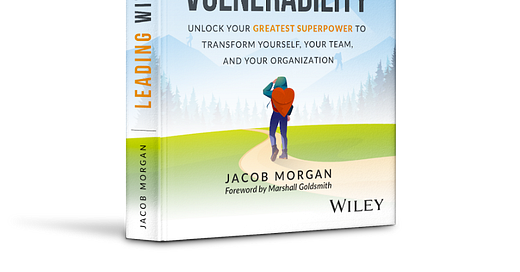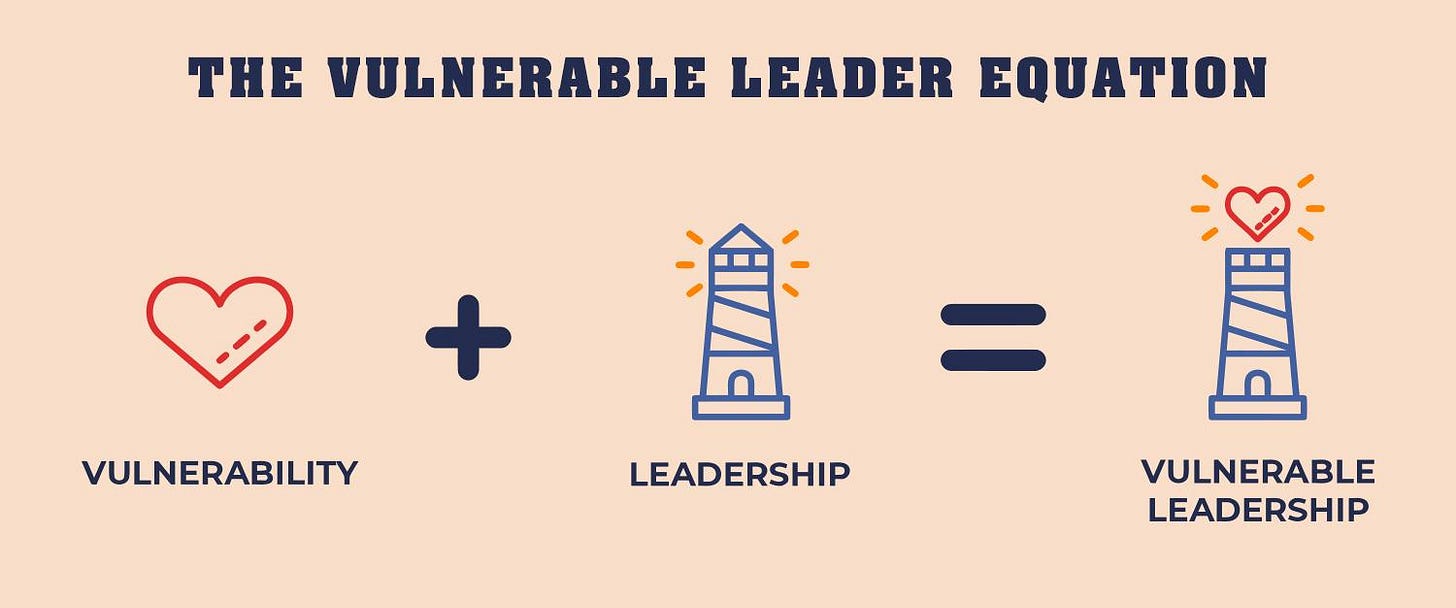The Digital Leader Newsletter — Strategies and Techniques for Change Agents, Strategists, and Innovators.
In this week’s Digital Leader Newsletter, we have a guest post from author & friend Jacob Morgan. He just released a great book titled “Leading with Vulnerability: Unlock Your Greatest Superpower to Transform Yourself, Your Team, and Your Organization”
Leading with vulnerability is not a fuzzy, feel-good topic. We are innovators and change agents. We move fast, optimizing for learning and testing. The nature of the game we play is that we make mistakes — hopefully the right types of mistakes, learn from them, and move forward.
A key part of our job is selling — selling concepts, selling the future, selling the unknown. Vulnerability is an essential ingredient in creating compelling narrative stories with pathos1, which is vital to have our audience(often your colleagues, investors, and teams) relate to, consider, care, invest and remember the otherwise dry facts and concepts you are pitching.
To have my own vulnerable moment…as an engineer who has slowly converted to employe the power of storytelling, this took me way too long to learn and appreciate. But I’m a bit slow in most everything.
Here’s a short excerpt from the book. Enjoy
We all experience vulnerability at some point in our lives, but few truly understand how to harness its power in leadership. Vulnerability, in essence, is the state of being exposed to the potential of emotional (or physical harm). While vulnerability cripples some leaders, others are able to tap into vulnerability and use it as a superpower to create trust, unlock the potential of others, lead through change, and drive business performance. What do they do and how do they do it?
Ann Mukherjee is the Chairman and CEO of Pernod Ricard North America, a company of approximately 1,900 employees. Born in India, she relocated to Chicago at the age of five, embracing the city's vibrant culture and the myriad of opportunities it offered. Although she has accomplished a lot in her life, it hasn’t been without a profound set of challenges.
At the young age of fourteen, Ann lost her mother in a tragic accident involving a drunk driver. A few years before that she was sexually assaulted by a drunk individual. These encounters might lead one to question her choice of leading a significant player in the alcohol industry. However, for Ann, these heart-wrenching experiences are not deterrents but catalysts for change. She believes in the power of transformation that arises from adversity, turning these tragic instances into opportunities for betterment. In her mind, she is not a victim, but an agent of change, a beacon of resilience and strength. She leverages her own personal trials not as a burden, but as fuel to incite growth and progress. Ann sees herself as a force of positivity who, through her leadership, can affect meaningful change and bring about a safer, more conscientious environment surrounding the consumption of alcohol.
According to Ann, “as a leader if you’re not comfortable with your own chaos and adversity then you are going to falter. You have to get over your own issues and build resilience as opposed to feeling like a victim which is one of the dangers facing the workforce today. Turn your pain, fear, and weakness into positive power. Being vulnerable allows you to connect with others to build that resilience but being a vulnerable leader allows you to take that connection and resiliency and do something positive with it to change the world.”
A vulnerable leader is a leader who intentionally opens themselves up to the potential of emotional harm while taking action (when possible) to create a positive outcome.
It’s easy to confuse vulnerability with leading with vulnerability so what is the difference?
Hollis Harris was the CEO of struggling Continental Airlines. On August 20, 1991, Harris sent out a memo to his workforce acknowledging that the company was in trouble and imploring his 42,000 employees to pray for the future of the company. The next day he was fired.
If Harris had been a junior employee, his statements might have gone unnoticed or received minimal attention. However, as a leader, his words carried immense weight and had a far-reaching impact. Doug Parker, the former Chairman and CEO of American Airlines, observed that Hollis's actions were indeed vulnerable, but lacked leadership.
Fleetwood Grobler is the CEO of Sasol, a South African energy company with around 30,000 employees. When he became CEO, the company was in dire shape. It was over $13 billion in debt and this was before the pandemic. Then during the pandemic the company really started to struggle to the point where the banks almost came in to take over the business. Fleetwood also had to address his workforce but his message was different from Hollis’s. Fleetwood also acknowledged that the business was struggling but said that he had a vision and an idea for how to turn things around. He asked his employees to come together to help him find the right path forward and promised them that if they join him to help him achieve this vision that they will be able to rebuild trust in their customers and their employees and turn the business around, and that’s exactly what happened.
Fleetwood wasn’t just vulnerable, he led with vulnerability. Meaning he brought together competence and connection.
Pretend for a moment that you made a mistake at work and you go to your leader to acknowledge and share what happened. That’s vulnerability. Leading with vulnerability would be you acknowledge the mistake, share what you learned, and then explain what you are going to do in the future to make sure that the mistake doesn’t happen again.
Bringing together leadership with vulnerability is what I call The Vulnerable Leader Equation and it’s the most important thing you can practice as a leader to create trust, lead through change, unlock the potential of those around you, and drive business performance.
Jonathan Pertchik is the CEO of TravelCenters of America. With almost 19,000 employees, he has focused on building vulnerability into the culture of the company as a way to drive innovation for new products and services. In fact, it’s this approach of combining leadership and vulnerability that allowed him to turn the company around and sell it for over $1.3 billion dollars to BP.
“Failure is built into how our company operates and innovates, which means that vulnerability is built into our culture and this is a conscientious effort. As an example, we may test out five or six different ideas in an area of our business knowing that most are likely to fail but one may give rise to success. We go into this process anticipating failure, mistakes, and challenges. Without vulnerability, there would be no innovation because nobody would feel safe to take risks, to think big, or to even talk about their failures. When I came into this role, the company was performing very poorly and the stock was under $9 and today our stock is the highest it’s been in fifteen years. There is no innovation without vulnerable leadership. It’s not easy, it’s not comfortable, and it’s the only way to lead.”
By 2030, our world is projected to have between 90 to 440 million leaders, with an estimated median figure of approximately 265 million individuals leading various organizations and initiatives. These leaders will not merely exist in their roles; they will hold significant influence over the lives of others and shape societal norms and job opportunities. Among these leaders, those who dare to lead with vulnerability and challenge the status quo possess the capacity to create significant positive change.
Organizational and global transformations require leaders who embrace vulnerability to navigate uncertainties and inspire others to follow suit.
Leading with vulnerability is not a sign of weakness, but a superpower that can transform lives, teams, organizations, and society as a whole. The Vulnerable Leader Equation combines the elements of connection and competence, allowing leaders to forge authentic relationships while effectively leading their teams.
When leaders dare to lead with vulnerability, they become the architects of positive change, steering humanity towards a brighter future. So, let us not be vulnerable at work; instead, let us lead with vulnerability.
Jacob is the best-selling author of 5 books including his most recent, Leading with Vulnerability: Unlock Your Greatest Superpower to Transform Yourself, Your Team, and Your Organization which is coming out in October. He’s also a speaker and professionally trained futurist whose work has been endorsed by the CEOs of Best Buy, Mastercard, Unilever, KPMG, Nestle, Cisco, and best-selling authors like Adam Grant, Mel Robbins, Patrick Lencioni, and Amy Edmondson. You can learn more about Jacob at TheFutureOrganization.com
PLEASE SHARE WITH YOUR COLLEAGUES. Subscriptions are free (or you can pay with some additional subscription benefits)
Onward!
John
About The Digital Leader Newsletter
John Rossman is an innovation coach and strategy advisor. The Digital Leader Newsletter is a weekly coaching session with a focus on customer-centricity, innovation, and strategy. We deliver practical theory, examples, tools, and techniques to help you build better strategies, better plans, and better solutions — but most of all, to think and communicate better.





